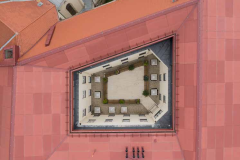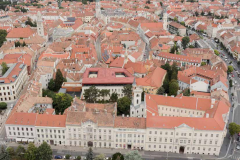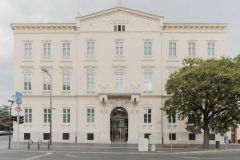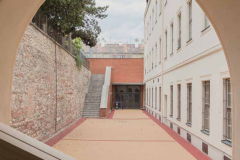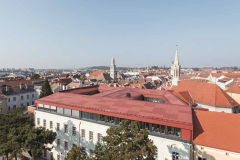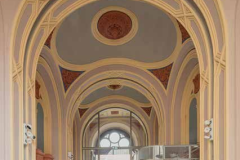Layers of Ages
St. Ursula Roman Catholic High School Extension, Sopron
Architect: Dávid Józsa
Text: Tamás Kiss
Photos: Balázs Danyi
The renewed building complex of the St. Ursula Roman Catholic High School in Sopron has undergone a comprehensive renovation, which included the expansion of the existing floor space, the zonal rationalisation of certain functions, the modernisation of te existing mechanical equipment system, the renovation of the facades as well as the preservation of the historic monument itself. The Order of St. Ursula, which settled down near the Sopron castle walls in the mid-18th century, has continuously expanded its buildings. In the middle of the 19th century, the Baroque complex was partially rebuilt in the revivalist neo-Gothic style and significantly enlarged, and later connected to Horváth House outside the castle wall by the arcaded Cifra corridor. Several important changes have now been made to the part of the building next to the Baroque convent and the Neo-Gothic church. The previously almost unused inner courtyards have been covered at floor level, the existing assembly hall has been significantly enlarged, and at first-floor level communal courtyards as well as a loft have been added. From the square, the rhythm of the extension and the “moustached” framework of the window shafts is no longer discernible. Above the old, somewhat austere facade sections of the inner courtyard, a dark band of windows and openwork metal shading structures came to balance the new roof structure. Above the old courtyard, with its curved or polygonal enclosure, a new rectangular extension encloses the airspace of the inner courtyards. The intention to redecorate the existing, inherited spatial configurations, the revision of our time, has involved the breaking up of layers of various ages.
Client: Diocese of Győr
General architecture: Archi.doc Architects
Leading architect: Dávid Józsa
Interior design: Dávid Józsa
Architect: Attila Erdei
Fellow architects: Lilla Pamuk, Norbert Takács, Dorottya Lukács
Structure: László Varga, Károly Bátki, Gergely Domonkos, Péter Kovács
Fire protection: István Böröcz
HVAC: Norbert Schöll, Tamás Mottl
Electrical engineering: Vilmos Szalmási
Acoustics: Gusztáv Józsa
Environment rehabilitation: Judit Horváthné Korinek
Kitchen technology: Tibor Kauser

